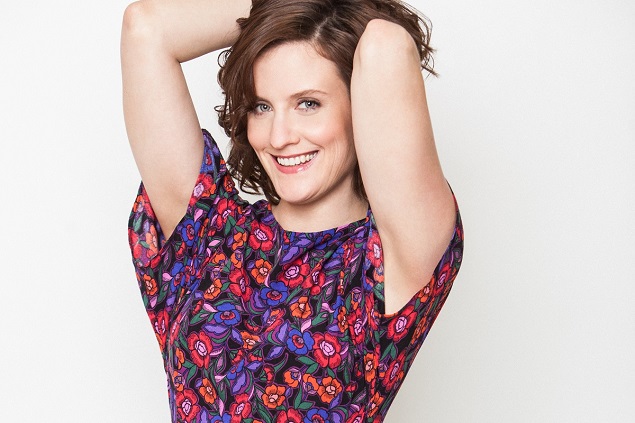‘Orange Is the New Black’ Spotlight: Julie Lake Dishes On Playing an Addict as ‘Angie Rice’

Actress Julie Lake stars in “Orange Is the New Black.” Photo: Vince Trupsin.
On Thursday, June 11, our favorite prison ladies were back to plotting each other’s downfalls, keeping paternity secrets, and busting terminally ill inmates out of jail (or at least that’s where they left us at the end of season two). Since its premiere in 2013, the dark comedy-drama series Orange Is the New Black has told the true-life story of Piper Kerman (Taylor Schilling), put away for felony money-laundering charges more than a decade after she committed the crime. Although the Emmy award-winning series focuses on Piper’s story, episode-by-episode, we learn why each inmate has arrived at Litchfield Penitentiary.
Distributed by Netflix, there’s a larger capacity for risqué storytelling than typical network television allows (aka nudity and truly impressive combinations of curse words). But beyond upping the ante with graphic encounters, the show also offers surprising sentimentality and compassion for the convicts. Prisoners are usually portrayed on TV as hardened criminals that belong in jail. OITNB challenges that black and white theory by showing there’s more to life behind the bars — and that not everyone deserves to be in Litchfield.
The show’s scrutiny to go beyond the status quo has also been applied to its real-life hiring choices, no doubt influenced by creator and writer Jenji Kohan. OITNB has been praised for its diverse casting through hiring more women and minorities, a feat that previously could only have been comparable to a Shonda Rhimes production. It’s paved the way for serious cultural analysis such as inequality in the prison system, systemic guard-inmate misogyny and the rights, or lack thereof, for jailed transgender women (spotlighting Laverne Cox’s character “Sophia”).
Beyond the larger themes of the show, each episode peels back more layers on the women in Litchfield, hence showcasing where their priorities truly lie. Recapping part of season two, it was a huge shock (for us and viewers alike) to learn that born-again Southern rebel Pennsatucky (Taryn Manning) was arrested for shooting a technician at an abortion clinic. She didn’t commit murder for her pro-life beliefs as her lawyers believe; shots were fired because the technician insulted Pennsatucky about her number of past procedures.
Angie Rice (Julie Lake) is one of Pennsatucky’s former followers, rounding out the clique of rural girls with past drug and present dental hygiene problems (read: yellow and brown cracked teeth). Appearing in OITNB at the end of season one, viewers have yet to learn the reason for Angie’s sentence in Litchfield. While she’s been more of a minor character in the past, she’s appearing in the majority of the upcoming season’s episodes. In preparation for seeing more of her in season three, GALO had an opportunity to speak with Lake about her transition from theatre to television, the makeup process to deconstruct rather than beautify, and behind-the-scenes moments with the cast.
GALO: Angie was a loyal supporter of Pennsatucky for a long time in the show. To catch us up for season three, can you tell us a bit about the breaking point that pulled her away and what brought her back?
Julie Lake: I think that Angie kind of just goes along with whatever Leanne (Emma Myles) wants. I think Leanne is the mastermind of their friendship and keeps her on Pennsatucky’s good side. I don’t think Angie would have it in her heart to reject Penn on her own; I think she feels empathy for her and is a kindhearted character in general. She’s pretty reliable in that perspective.
GALO: Angie has a diverse role in Litchfield, even though she’s part of a clique. We see her in a lot of fun scenes practicing yoga, on the hunger strike that ends in pizza, and tricks against corrections officer Sam Healy, among others. Do you ever improvise these scenes or does everyone stay within the confines of the script?
JL: I improvise when I can get away with it. So sometimes at the end of the scene, I will [do that]. But mostly, it’s written. I’m definitely free with it when I can be. Often, Emma and I will improvise little bits and stuff, physical comedy bits like clapping [our] hands or putting our hair back. Sometimes we talk about it and sometimes we do it in the moment. A lot of the time, we have a funny idea before shooting — if they hate it, they’ll let us know, but that doesn’t usually happen.
GALO: On Instagram, you recently posted a picture of you and Emma Myles. It’s great to see how genuinely close so much of the cast is. What do you attribute this to?
JL: I’m really grateful to Emma. My first day on set, I was so nervous. I had never been on a TV set before and I thought I was going to have a panic attack. She introduced me to everyone and put me at ease. She’s so chatty, such a warm and friendly person, that she made my experience on the show so wonderful.
But there is not one bad egg in the cast. You know, the Orange cast is so close, we hang out outside of the show as well as downtime during the show. Like, we’ll pile into a dressing room and watch stupid videos on YouTube.
GALO: Your character puts a more sympathetic angle on what it’s like to be locked up for drugs. How did you prepare for a role like this?
JL: I watched a lot of interventions. I watched this documentary [a few years] before called High on Crack Street: Lost Lives in Lowell, and there was one character named Brenda who really stuck with me. She was so funny but so sad at the same time. I didn’t completely model Angie on her, but she was in my mind the entire time.
